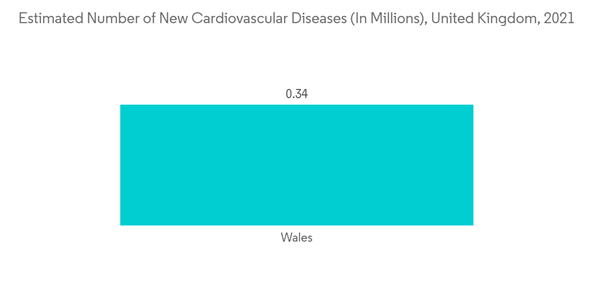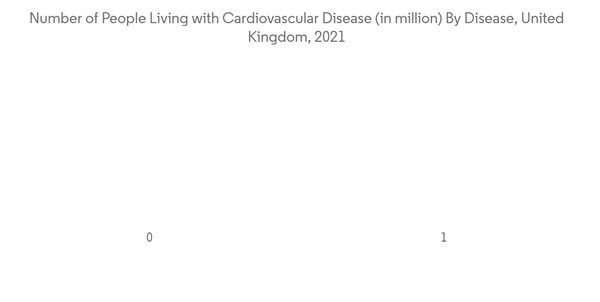The COVID-19 pandemic affected the market for diagnostic imaging equipment in the United Kingdom. Several factors, such as setbacks in manufacturing the radioisotopes, contributed to the shortage of radiopharmaceuticals. For instance, in January 2022, the High Flux Reactor in the Netherlands was temporarily shut down due to a water leak in the reactor's cooling system. The disruption impacted the production of Mo-99 and Lu-177. Although production from other facilities will likely help in improving the scarcity, shortages are still expected, as per the Nuclear Medicine Europe Emergency Response Team. However, though the COVID-19 pandemic had a slightly adverse effect on the studied market during the initial period, the use of diagnostic imaging services increased during the pandemic, positively impacting the UK diagnostic imaging equipment market in the latter part of the pandemic. For instance, a research study published in the National Library of Medicine in February 2021 found that patients suspected of having COVID-19 pneumonia required routine diagnostic imaging, notably chest radiography and chest CT. Chest CTs and radiographs of the affected individuals were used to confirm that pneumonia associated with COVID-19 had occurred in those patients. As the pandemic progressed, there was a growth in the use of diagnostic tools for COVID-19 identification, which helped the market grow.
Certain factors that are driving the market growth include the prevalence of chronic diseases and the growing adoption of advanced technologies in medical imaging.
The incidence and prevalence of chronic diseases, such as cardiovascular diseases, musculoskeletal diseases, cancer, and neurological disorders are increasing rapidly in the country, which is pushing the demand for diagnostic equipment. Diagnostic imaging also plays a vital role in the diagnosis and management of cardiovascular diseases. There is a large prevalence of cardiological disorders in the nation, which is expected to boost the demand for diagnostic imaging services, thereby propelling market growth. According to the 2022 UK Factsheet published in August 2022 by the British Heart Foundation, over 7.6 million people in the United Kingdom were living with heart and circulatory diseases as of August 2022. The large population affected by cardiovascular diseases, along with the associated high annual healthcare costs, are expected to boost the growth of the studied market in the country over the forecast period.
The aging population is increasing. These older adults are more susceptible to chronic illnesses, such as musculoskeletal ailments, joint problems, cardiovascular abnormalities, and brain abnormalities. For instance, Gov.UK estimated that in July 2022, 4% of patients in England who were 65 years or above were suffering from dementia or Alzheimer's disease. Due to the increased prevalence of age-related disorders, there will likely be a greater demand for diagnostic imaging tools like magnetic resonance imaging (MRI) for detecting brain abnormalities linked to moderate cognitive impairment (MCI). This will likely lead to a growth in the market for these tools.
The market growth is also projected to be aided by the development of automated diagnostic imaging scanners, cutting-edge technology, and expanding corporate activities in the research and development of diagnostic imaging equipment. For instance, in May 2021, Fujifilm (Hitachi, Ltd.) published the results of the first real-world experiment using the FDR Xairportable X-ray system in community care. The trial was conducted in collaboration with Fujifilm (Hitachi, Ltd.) United Kingdom, Northumbria Healthcare, National Health Services (NHS) Foundation Trust, and the Northeast Ambulance Service; it resulted in a considerable decrease in hospitalizations.
However, expensive procedures and equipment are likely to restrain the market growth.
United Kingdom Diagnostic Imaging Equipment Market Trends
MRI Segment is Expected to Hold a Significant Market Share Over the Forecast Period
The magnetic resonance imaging (MRI) segment is expected to witness significant growth in the market owing to factors such as an increasing prevalence of chronic diseases (such as cardiovascular diseases, musculoskeletal diseases, cancer, and others), a growing geriatric population, and technological advancements.For instance, the 2021 United Kingdom Factsheet estimated that as of January 2022, about 7.6 million people in the United Kingdom (4 million men and 3.6 million women) were affected by heart and circulation disorders. Therefore, the rising prevalence of chronic diseases among the population is anticipated to increase the need for diagnostic imaging tools for the detection of cancer/tumor and cardiac conditions, as well as for the planning of treatments, such as surgery or other therapies.
Furthermore, growing company activities in developing advanced diagnostic equipment and establishing diagnostic facilities are expected to increase the demand for these equipment, thereby boosting the market growth. For instance, a new magnetic resonance imaging (MRI) scanner facility costing EUR 3.1 billion (USD 3.08 billion) opened in Leicester in July 2021. As a result, researchers will be able to photograph up to 1500 extra patients, suffering from cardiovascular diseases, annually. Additionally, the British Heart Foundation (BHF) has provided a donation of EUR 1 million (USD 990,000) for this new scanner facility, which will be held jointly by Leicester's Hospitals with a EUR 1 billion gift (USD 990 million). Similar to this, the Royal Free Hospital in the United Kingdom installed 3 brand-new high-field 3T MRI scanners in March 2021 to increase scanning capacity and enable cutting-edge scanning techniques.
The National Health Service England reported that in May 2022, there were around 3,729,620 magnetic resonance imaging (MRI) treatments carried out on NHS patients in England (as of January 2021 - January 2022). Additionally, 299,615 more magnetic resonance imaging (MRI) procedures were carried out in January 2022 than in December 2021 (299,615). Thus, it is anticipated that the growth of the studied segment will be aided throughout the forecast period by the increasing number of imaging operations in England.
Thus, the increasing burden of chronic diseases among the population and growing investments by the government and hospitals to establish scanning facilities are expected to increase the demand for various advanced diagnostic imaging equipment, thereby propelling market growth.
Cardiology Segment is Expected to Hold a Significant Market Share Over the Forecast Period
By providing strategic benefits in diagnostic and therapeutic decision-making, medical imaging plays a crucial part in managing heart-related disorders. It provides vital inputs for diagnosis, staging, treatment, prognosis, and follow-up. Furthermore, echocardiography (echo), cardiac magnetic resonance imaging (MRI), and cardiac computed tomography (CT) scanning are some of the advanced cardiac imaging procedures. These operations are minimally invasive, virtually painless, and in some cases, merely require an intravenous (IV) insertion. In the United Kingdom, prevalence of cardiac diseases is increasing. As imaging modalities provide clarity on the condition of the heart, they are gaining demand in the country, which is anticipated to fuel the segment's growth.According to the British Heart Foundation's (BHF) fact sheet released in August 2022, the disease burden from heart and circulatory diseases is high, estimated at USD 10.7 billion (GBP 9 billion)per year for the United Kingdom. This is anticipated to contribute to the demand generation for diagnostic imaging procedures, propelling the cardiology segment's growth over the forecast period. Moreover, the acquisition of modalities by end users is anticipated to further fuel the segment's growth. For instance, in February 2022, the John Radcliffe Hospital, a part of Oxford University Hospitals NHS Foundation Trust (OUH, Oxford, UK) started using photon-counting CT, NAEOTOM Alpha (Siemens Healthineers), a high-resolution and dose reduction technology.
Thus, technological developments and constant government activities are likely to drive future growth of the segment.
United Kingdom Diagnostic Imaging Equipment Industry Overview
The market studied is consolidated owing to the presence of a few major players in the market. The market players are focusing on research and development activities to develop technologically advanced products in order to reduce the cost and side effects associated with the products. The barriers to new entrants are high in this market, and hence few major players hold most of the market share. Some of the key players in the market include Carestream Health Inc., Fujifilm Holdings Corporation (Hitachi, Ltd.), GE Healthcare, Koninklijke Philips N.V., Siemens Healthineers, and Esaote SpA.Additional Benefits:
- The market estimate (ME) sheet in Excel format
- 3 months of analyst support
This product will be delivered within 2 business days.
Table of Contents
Companies Mentioned (Partial List)
A selection of companies mentioned in this report includes, but is not limited to:
- Carestream Health Inc.
- Esaote SpA
- Fujifilm Holdings Corporation (Hitachi, Ltd.)
- GE Healthcare
- MR Solutions Ltd.
- Hologic Inc.
- Koninklijke Philips N.V.
- Shimadzu Corporation
- Siemens Healthineers
- Canon Medical Systems Corporation










